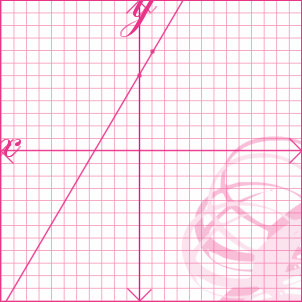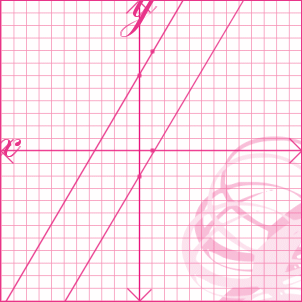Parallel & Perpendicular Lines
Haha, everyone loves the dancing banana. Well anyways, it's Jackie here. This is my first whack at scribing so don't mind me of I sound totally out of line .. don't say i didn't warn you. d: Oh, and thank you Wendy for your post prior to this. That was very sweet of you, big heart. (: Well, getting on to business, let's have a look at what we learned today in classroom 69.
:D
Today, Mrs. Ingram established the relevance of graphing parallel and perpendicular lines, and how to calculate them. The lesson started off with graphing our first line, given the equation -2x + y = 6. We want to find the slope intercept of this equation so that we can set it up on a graph.
SLOPE INTERCEPT FORM :y = mx + b
where m = slope.
where b = y-intercept.
So, once we rearrange this equation into slope-intercept form, we get y = 2x + 6. Here, I will demonstrate how to calculate your slope and y-intercept ..
- 2x + y = 6
+ 2x + 2x
--------------
y = 2x + 6
m = 2/1 ; b = 6
Because we've already singled out the y, we now know that our slope (m) = 2/1, and that our y-intercept (b) = 6. Now, you can see how we graph this on my girly pink graph template .. =D

oh, just a friendly reminder .. always remember to label your x-axis and y-axis, as well as mark the arrows on your lines to indicate that they continue in both directions .. sorry, i was lazy to mark them on my graph but i think you get the point. :)
Now that we have our first line on the graph, we were given our second line to graph. The equation was -4x + 2y = -2. Following the same procedures as to what we did with the first equation, we rearrange the equation into slope-intercept form to find .. you guessed it, the slope and the y-intercept.
-4x + 2y = -2
+ 4x + 4x
--------------
2y = 4x - 2
___________
2
y = 2x - 1
m = 2/1 ; b = -1
Surprise, now it's time to put our second line on the graph.

Now, looking at the graph .. you see that both the lines that we have traced onto the graph are parallel (//), meaning that they will continue both ways and never meet.
Wasn't that fun? (: Okay, now here's something new. We were given a third line to put onto the graph ..
x + 2y = 12
- x - x
-------------
2y = -x + 12
____________
2
y = -x/2 + 6
m = -1/2 ; b = 6
Now that we calculated our third line, we trace it onto the graph like so ..

Looking at the graph, we can see that the first and third line that we made are perpendicular, meaning they cross each other. To determine the perpendicular line of a given slope, we calculate the negative reciprocal. This basically means that we turn it over and change the sign.
ex: m = -3/2
m (penpendicular, don't have the symbol for it on the keyboard :|) = -2/3
We were given a few sample questions to solve that helped us better understand this "perpendicular/parallel" line theory .. majig.
* question one: Write the equation of a line that passes through (-2,4) and is perpendicular to 2x - 3y + 5 = 0.
1: Calculate the slope of the existing line.
You do this by rearranging the equation into slope-intercept form. y = mx + b
+ 3y + 3y
--------------------
2x + 5 = 3y
___________
3
2x/3 + 5/3 = y
m = 2/3 ; b = 5/3
2: What's the perpendicular slope?
m = 3/2 .. so !
m (perpendicular) = -3/2
3: Determine the equation using the point-slope form. In the equation, replace all the terms that you arleady know and solve from then on.
(2) y - 4 = -3/2 ( x + 2 ) (2)
2 ( y - 4 ) = -3 ( x + 2 )
2y - 8 = -3x - 6
+ 8 + 8
----------------
2y = -3x + 2
___________
2
y = -3x/2 + 1
general form: 3x + 2y = 2
standard form: 2x + 2y - 2 = 0
* question two: Determine the equation of a line with the x-intercept of 2 and is parallel to the line 3x - 2y = 6.
1: Calculate the slope of the existing line.
You do this by rearranging the equation into slope-intercept form. y = mx + b
(Remember, when switching values from one side of the equation to the other, negatives become positives and vice-versa.)
3x - 6 = 2y
___________
2
3x/2 - 3 y
m = 3/2 ; b = -3
2: What's the perpendicular slope?
m = 3/2 .. so !
m (perpendicular) = -2/3
3: Determine the equation using the point-slope form. y - y1 = m ( x - x1 ) In the equation, replace all the terms that you arleady know and solve from then on.
(2) y - 0 = 3/2 ( x - 2 ) (2)
2y = 3 ( x - 2 )
2y = 3x - 6
___________
2
y = 3x/2 - 3
general form: 3x/2 - y = 3
standard form: 3x/2 - y - 3 = 0
Well, that's basically all you need to know on what we've learned today in class on parallel & perpendicular lines. We were assigned exercise 14, omitting questions 10 & 11. Well, that was pretty easy right? Good luck to everyone with the questions .. and trying to understand my scribe. d: that's all for now, folks. :)
And a do - doodle - loo - do .. ?

4 Comments:
At 2:08 a.m., March 07, 2006, Mrs. Ingram said…
Mrs. Ingram said…
Congrats. That's a fantastic scribe post! I especially liked your girly pink graph template.
At 9:38 p.m., March 07, 2006, wendy ^_^ said…
wendy ^_^ said…
terrific job jackie. i love your scribing. =) it is 100% FAB! =) i love the pink graph and the way it matched the whole bloggg =) great great greattttt and GREAT scribe.
At 5:24 p.m., March 08, 2006, Jackie Doming said…
Jackie Doming said…
aw, thank you mrs. ingram and wendy. (: it just goes to show that a little effort goes a long way. (y)
At 1:39 p.m., February 14, 2009, summerhush said…
summerhush said…
Thanks that is very helpfull~ i was looking for a explaintion and it was googled to me
Nancy
Post a Comment
<< Home